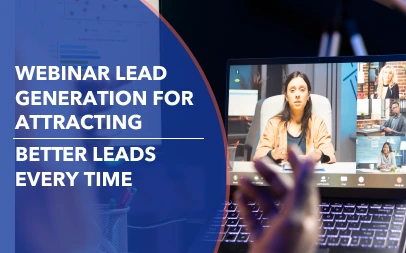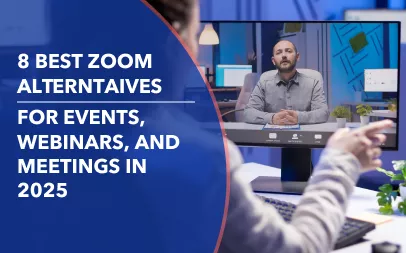
Webinars have gained immense popularity in recent years, revolutionizing the way we connect, communicate, and learn. Understanding the concept of a webinar is crucial in today's fast-paced digital world, where distance is no longer a barrier to knowledge sharing and collaboration. In this article, we will delve into the definition and purpose of a webinar, explore the different types of webinars, analyze the components of a successful webinar, and discuss the benefits of hosting one.
Understanding the Concept of a Webinar
Before we dive into the intricacies of webinars, let's establish a clear understanding of what they are and their purpose.
Webinars have become an integral part of the digital landscape, revolutionizing the way people learn, collaborate, and engage with one another. In this expanded version, we will explore the definition, purpose, and evolution of webinars, shedding light on their significance in today's interconnected world.
Definition and Purpose of a Webinar
A webinar, short for web seminar, is a live or pre-recorded online event that brings people together to exchange knowledge, demonstrate products or services, and engage in interactive discussions. Unlike traditional seminars or workshops, webinars eliminate geographic barriers, allowing participants from across the globe to join and interact from the comfort of their own homes or offices.
Webinars serve as a powerful tool for businesses, educational institutions, and organizations of all sizes to disseminate information, engage with their audience, and build strong relationships. They provide a platform for experts and thought leaders to share their expertise, while also offering participants the opportunity to learn, ask questions, and gain valuable insights.
Furthermore, webinars facilitate remote learning, training, and collaboration, enabling individuals to enhance their skills and knowledge without the need for physical presence. This flexibility and convenience make webinars an attractive option for both organizers and participants.
The Evolution of Webinars
Webinars have evolved significantly since their inception. Initially, they were limited to audio-only formats, where participants could listen to the presenter but could not visually engage. However, advances in technology have made it possible for webinars to incorporate video, screen sharing, chat features, and interactive elements.
Today, webinars have become more interactive and engaging, allowing for real-time audience participation through polls, Q&A sessions, and live chats. Participants can actively contribute to the discussion, share their thoughts, and ask questions, creating a dynamic and collaborative learning environment.
Moreover, the evolution of webinars has not only enhanced the learning experience but has also opened up new avenues for businesses to promote their products and services effectively. With the integration of multimedia elements, presenters can showcase their offerings in a visually appealing and compelling manner, capturing the attention of the audience and driving engagement.
Additionally, webinars provide an opportunity for businesses to gather valuable feedback and insights from their target audience. Through interactive features such as surveys and feedback forms, organizers can collect data, analyze trends, and make informed decisions to improve their products or services.
As technology continues to advance, we can expect webinars to further evolve, incorporating virtual reality (VR), augmented reality (AR), and other immersive technologies. These advancements will undoubtedly revolutionize the webinar experience, making it even more immersive, interactive, and impactful.
In conclusion, webinars have transformed the way we learn, collaborate, and engage with others. With their ability to bridge geographical barriers, facilitate remote learning, and provide interactive experiences, webinars have become an indispensable tool in the digital age. As we continue to embrace the power of technology, webinars will continue to evolve, offering new possibilities and opportunities for individuals and businesses alike.
The Different Types of Webinars
Webinars come in various forms, tailored to specific objectives and target audiences. Let's explore some of the most common types:
Educational Webinars
Educational webinars focus on delivering valuable content and insights to participants. They are often conducted by subject matter experts, industry leaders, or educators aiming to share knowledge, expertise, and best practices. These webinars cover a wide range of topics, from professional development to technical skills training.
For example, a marketing expert might host an educational webinar on effective social media strategies for small businesses. They would provide step-by-step guidance on how to create engaging content, optimize ads, and measure campaign success. Participants would gain practical knowledge and actionable tips to enhance their social media marketing efforts.
In another educational webinar, a renowned chef might share their culinary expertise, demonstrating cooking techniques and sharing secret recipes. Participants would have the opportunity to learn from a master chef, ask questions, and improve their cooking skills.
Promotional Webinars
Promotional webinars, as the name suggests, are designed to promote products, services, or upcoming events. They serve as a sales and marketing tool, providing participants with in-depth information about a specific offering, demonstrating its value, and enticing them to take action.
For instance, a software company might host a promotional webinar to showcase their latest product release. The webinar would highlight the product's features, benefits, and how it solves common pain points for businesses. Through live demos and customer testimonials, participants would gain a comprehensive understanding of the product's capabilities and be motivated to make a purchase.
In another example, a fashion brand might host a promotional webinar to introduce their upcoming collection. The webinar would showcase the latest trends, styling tips, and exclusive discounts for participants. By creating a sense of exclusivity and urgency, the brand would generate excitement and encourage participants to shop their new collection.
Interactive Webinars
Interactive webinars emphasize engagement and two-way communication between the presenter and participants. They allow for real-time interactions, such as live polls, quizzes, and audience Q&A sessions, making the learning experience more dynamic and personalized.
Imagine attending an interactive webinar on personal finance. The presenter would not only share valuable insights on budgeting, investing, and saving, but also conduct live polls to gauge participants' financial habits and knowledge. Through interactive quizzes, participants would be able to test their understanding of key concepts and receive immediate feedback. The webinar would conclude with an audience Q&A session, where participants could ask specific questions and receive personalized advice.
In another interactive webinar, a fitness expert might lead a virtual workout session. Participants would follow along in real-time, performing exercises and receiving feedback from the expert. Through interactive elements like virtual high-fives and motivational messages, the webinar would create a sense of community and encourage participants to stay active.
These are just a few examples of the different types of webinars available. Whether you're looking to expand your knowledge, promote a product, or engage with your audience, webinars offer a versatile platform to achieve your goals.
The Components of a Successful Webinar
A successful webinar requires careful planning, compelling content, and effective audience engagement strategies. Let's explore the key components:
Planning and Preparation
Thorough planning is essential to ensure a smooth and impactful webinar. Define your goals, target audience, and desired outcomes. Select a suitable topic and choose the right date and time considering your participants' availability. Prepare a detailed agenda and outline specific talking points or slides to guide your presentation.
Additionally, consider the technical aspects of your webinar. Test your equipment, internet connection, and audio/visual settings beforehand to avoid any technical glitches. Familiarize yourself with the webinar platform you will be using and ensure that you are comfortable navigating its features. Practice your presentation and ensure that your delivery aligns with the tone and pace you intend to maintain during the webinar.
Furthermore, it is important to consider the logistics of your webinar. Will you be hosting it live or pre-recording it? Will there be guest speakers or panelists? These are all factors that need to be taken into account during the planning and preparation phase.
Content Creation for Webinars
Creating compelling and valuable content is the backbone of a successful webinar. Structure your content logically, starting with an engaging introduction to capture your audience's attention. Clearly define the objectives of your webinar and outline the main points you will be covering.
When creating your content, it is important to strike a balance between informative and interactive elements. Incorporate opportunities for participant engagement throughout the webinar, such as interactive quizzes or discussions, to maintain interest and promote active learning. Consider using real-life examples, case studies, or visuals to illustrate your points and make them more relatable to your audience.
Remember to keep your content concise and focused. Avoid overwhelming your audience with too much information and ensure that each point you make is clear and easy to understand. Use visuals, such as slides or infographics, to enhance the visual appeal of your webinar and reinforce your key messages.
Engaging the Audience
Engaging your audience is key to a memorable webinar experience. Encourage participation through live chats, Q&A sessions, and interactive polls. By creating opportunities for your audience to actively engage with the content, you can foster a sense of involvement and make the webinar more interactive.
In addition to interactive elements, consider incorporating storytelling techniques or asking thought-provoking questions to stimulate discussion and promote deeper engagement. Sharing personal anecdotes or relevant stories can help create an emotional connection with your audience and make the content more relatable.
During the webinar, make sure to address questions and comments from participants in a timely and inclusive manner. This will create a sense of community and connection among the attendees. Actively encourage participants to share their thoughts and opinions, and be open to different perspectives.
Lastly, remember that engaging visuals can enhance the overall experience of your webinar. Use slides, videos, or infographics to complement your content and make it more visually appealing. Visuals can help reinforce key messages and provide a break from continuous talking, keeping your audience engaged and focused.
The Benefits of Hosting a Webinar
Hosting a webinar can bring numerous benefits to individuals and organizations alike. Let's explore some of the advantages:
Building Brand Awareness
Webinars provide an opportunity to showcase your expertise, enhance credibility, and position your brand as a thought leader in your industry. By delivering high-quality content to a diverse audience, you can significantly increase brand visibility and awareness, expanding your reach and attracting new followers or customers.
For example, imagine you are a marketing consultant specializing in social media strategies. By hosting a webinar on the latest trends and best practices in social media marketing, you can demonstrate your knowledge and skills to a wide range of participants. This exposure can lead to increased recognition and potential collaborations with other industry professionals.
In addition, webinars allow for interactive engagement with participants, enabling you to answer questions, address concerns, and provide personalized insights. This level of interaction not only strengthens your brand's reputation but also fosters a sense of community among your audience.
Establishing Authority in Your Field
Webinars enable you to share unique insights and knowledge, establishing yourself or your organization as an authority in your field. By offering valuable information and demonstrating expertise, you can build trust and credibility among your target audience, ultimately leading to stronger customer relationships and increased loyalty.
For instance, let's say you are a healthcare professional specializing in nutrition. By hosting webinars on topics such as healthy eating habits, the impact of different diets on overall well-being, and debunking common nutrition myths, you can position yourself as a trusted source of information in the industry. This authority can attract clients seeking guidance on their health journeys and open doors for collaborations with other healthcare professionals.
Furthermore, webinars provide an opportunity to showcase case studies, success stories, and testimonials from satisfied customers. This social proof further solidifies your authority and helps potential clients or customers make informed decisions.
Generating Leads and Sales
Webinars present an effective opportunity to generate leads and convert them into paying customers. By capturing participant information during registration, you can build a valuable database and follow up with targeted marketing campaigns or personalized offers. The in-depth knowledge and engagement offered during webinars can help nurture leads and drive conversions.
For example, suppose you are an e-commerce business owner specializing in handmade jewelry. By hosting webinars on jewelry trends, styling tips, and the art of craftsmanship, you can attract individuals interested in your products. During the webinar, you can collect participant information, such as email addresses, which can be used for future marketing efforts. Additionally, by offering exclusive discounts or limited-time promotions during the webinar, you can incentivize participants to make a purchase, leading to immediate sales.
Moreover, webinars provide an opportunity to showcase the unique features and benefits of your products or services. By demonstrating how your offerings can solve specific problems or meet the needs of your target audience, you can effectively communicate the value proposition and drive sales.
In conclusion, webinars have transformed the way we learn, connect, and share information. Their convenience, versatility, and accessibility make them a powerful tool for individuals, businesses, and educational institutions alike. By understanding the concept of webinars, exploring their types, mastering the essential components, and recognizing the benefits, you can harness the full potential of this modern communication and collaboration platform.
Like what you see?
Inspired to take your webinars and virtual events to the next level? Unlock the full potential with Remo's cutting-edge platform Elevate your gatherings with Remo's dynamic features. Sign up today and embark on a journey of unforgettable connections and growth! Book a demo today!




























